Bob A. Gove Blog
Tuesday, April 23, 2019
When Parents Cannot Let Go: Insights Highlighted by the College Admissions Scandal
from The New Social Worker Online — the professional social work careers magazine http://bit.ly/2URux8H
Marketing Tips to Glean Graduates

Graduation 2019 is around the corner - start booking trials and Graduation Day appointments now. Graduation season begins in May and runs through the month of June. Providing special graduation day services provides an opportunity to introduce your salon to students of all ages - this is especially relevant to salons located in college-towns. This walk across the stage serves up a huge opportunity to offer ‘celebrate the graduate packages can bring extra business to your beauty business the last weeks of spring.
Junior high, high school, college and university graduates across the country are spending money on men's and women's hair, makeup, brow shaping, facials, sunless tanning, manicures and pedicures. Be sure to build the Graduation season into your marketing calendar every year. Here are a few ways:
1) Offer Special Graduation Promotion Packages.
Creating affordable packages geared toward students generates new business, use graduation season as a chance to connect with students directly. Put together packages at 3 different price points and secure appointments with a 50% deposit (non-refundable).
2) Referrals Rock.
Talk up your graduation services and promotions to current clients starting several weeks in advance. Word of mouth is one of the best ways to market your business. Try a friend referral offer for graduation services. For example: Schedule graduation services for yourself and a friend, receive Lash Application for free.
3) Offer special splurges.
If there’s ever a time that a student to splurge for a fancy hair clip, earrings or lip gloss, it’s for graduation. Even if you don’t typically stock these kinds of items, investing in some beauty accessories and displaying attractively in key retail area/s boosts the bottom line every time.
4) Check the dates for local graduations.
Call your local junior highs, high schools, colleges and universities to ask graduation ceremony dates. These dates will change every year, so in order to plan and staff accordingly make sure these dates are highlighted in your calendar.
5) Socialize.
Target graduates by posting "graduate-related" content May - June. Share inspirational quotes, congratulations and graduation planning tips. Facebook ads are a great place to start advertising special graduate offers and services.
6) Graduation Packages Email.
When the time comes to plan graduation day beauty services make sure your salon is “top of mind” of regional graduates. Send an e-mail campaign to promote your graduate packages. For easy booking offer simple price points with memorable package names such as "Top of the Class", "Follow Your Dreams", "Valedictorian", or "One Smart Cookie". Get creative!
7) Gift Cards for Grads.
Gifts for high school and college students should be highlighted at this time as well. Gift cards are the perfect gift, remind gift givers by displaying prominently with graduation cards.
from Beauty Business Blog http://bit.ly/2PqfCfv
Monday, April 22, 2019
Clinical Intersections: Grief, Trauma, and Complex Trauma - 5 Questions & Answers for Social Workers
from The New Social Worker Online — the professional social work careers magazine http://bit.ly/2L5LebE
Saturday, April 20, 2019
Top Five Ways to Spend Your Dry Day in Raja Ampat
Most divers know of Raja Ampat, one of the world’s best scuba-diving destinations. This Indonesian archipelago is also known as the Four Kings. Justifiably, it attracts scuba enthusiasts from around the world who dream of a colorful and abundant underwater wonderland. Raja Ampat’s spectacular marine world gets a lot of attention from journalists, photographers, and scuba fans, but Raja offers equally stunning topside attractions. If you’re planning a land-based trip here for your next scuba adventure, stay near Waigeo to enjoy some of these unique topside attractions.
Pianemo
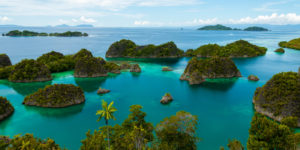
Pianemo offers iconic Raja scenery.
You may have seen iconic photos of a cluster of island mounds floating in an ocean of turquoise. Photos of Pianemo represent Raja Ampat in almost every media outlet, travel magazine, and marketing tool. And understandably so, as the view from the top of Pianemo leaves most people speechless.
If you’re staying in any of the islands around Waigeo, you can hire a speedboat to take you to Pianemo. From the main town of Waisai in Waigeo, the trip can take about 1.5 hours one way. Even though Pianemo has become a bit touristy, the view makes the trip worthwhile.
Arborek village
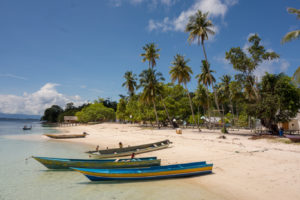
Local village in Raja (Credit: Mo Ohashi)
As part of the Indonesia government’s tourist program, the tiny island of Arborek and its native Papuan habitants offer performances with traditional dance and music to introduce visitors to a unique cultural experience. The white-sand beaches surrounding the island, the local village life, and stunning reefs just offshore make this enchanting island a must-visit if you are staying in Waigeo. Arborek village also offers simple accommodations, souvenir shops, small stands for snacks and drinks and even a dive center. Conveniently located en route to the famous Pianemo, Arborek makes for a great stopover.
Bird watching

Wilson’s bird of paradise competes to attract a female by dancing on the forest floor.
Raja Ampat is home to endemic Birds of Paradise (Cendarawasih) which, according to National Geographic, are “some of the world’s most dramatic and attractive birds.” Aside from the colorful and vibrant colors, the Cendarawasih birds are also renowned for being fabulous dancers and singers. Of the 41 Cenderawasih species in Indonesia, 37 live in the Papua region alone. Two of these species in particular — Wilson’s Bird of Paradise and Paradise Red — are endemic to Raja Ampat. They most commonly live in the jungles of Batanta and Waigeo.
Since these rare birds appear mostly in the early mornings from around 5:30 to 6:30 am, you can even squeeze in a birdwatching tour before you dive. Many local guides will be happy to show you around.
Jungle exploration
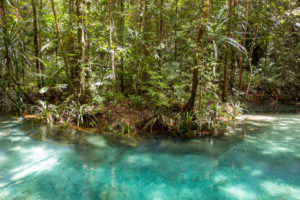
Kalibiru River lies deep in the jungle. (credit: Mo Ohashi)
Much of Raja remains relatively untouched and unexplored rainforest, abundant with fascinating wildlife and plant species. In the thick jungle of Waigeo, you can find Kalibiru, the highlight of my last trip to Raja Ampat. This crystal-clear, turquoise freshwater river runs through the lush, green forest. Even more spectacularly, you can watch this river originating from the ground, gushing out between the rocks and dirt at your feet.
Island hopping
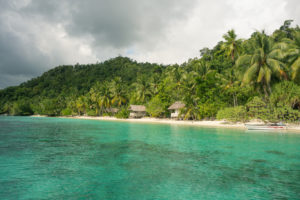
Island hopping in Raja means visiting paradises like this. (credit: Mo Ohashi)
Aside from the four main islands that make up Raja Ampat, smaller islands are also dot the region. Most have beautiful lagoons, white-sand beaches, and shallow reefs. Often, you can simply jump in with your mask and snorkel and encounter reef sharks, turtles, and even dugongs if you’re lucky.
Hire a speedboat for the day and explore some of the remote, uninhabited islands, with some of the planet’s most stunning shades of blue. No matter how you choose to spend your topside time in Raja Ampat, it will not disappoint you.
Mo Ohashi is a Bali-based scuba instructor whose current passions include coconut ice cream, rescuing street dogs, and sharing her travel tips and resources on Travelust 101. You can follow her adventures on Instagram and contact her for tips on guides for Kalibiru.
The post Top Five Ways to Spend Your Dry Day in Raja Ampat appeared first on Scuba Diver Life.
from Scuba Diver Life http://bit.ly/2KUsXOz
Thursday, April 18, 2019
Keep On Walking
from The New Social Worker Online — the professional social work careers magazine http://bit.ly/2GfThwU
Preserving America’s Underwater Battlefield: E.M. Clark
From January to the end of August 1942, German U-boats attacked more than 285 vessels in North American waters. Just off coastal North Carolina, the remnants of many of these ships are scattered on the ocean floor. The remains of this little-known battlefield serve as the final resting place for 90 ships and nearly 1,700 men lost during the Battle of the Atlantic. Over the course of the battle, eight Allied convoy vessels, 78 merchant freighters and tankers and four German U-boats sank off North Carolina’s coast. Each shipwreck tells a unique story; today we visit the E.M. Clark.
E.M. Clark sinks
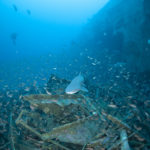
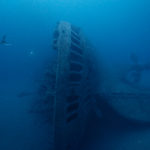
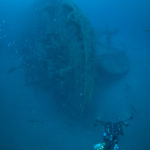
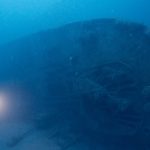
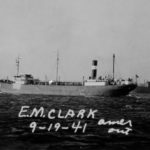
During World War II, E.M. Clark was part of a larger transportation network that carried petroleum products to support the Allied war effort both at home and abroad. Standard Oil Company of New Jersey owned the ship, which made 41 voyages from 1939 to 1941, carrying over 4 million barrels of petroleum products. In 1942, E.M. Clark completed two trips, but its third trip for the year would it be its last.
On March 11, 1942, E.M. Clark left Baton Rouge, Louisiana carrying 118,000 barrels of heating oil destined for New York. As darkness fell the evening of March 17, the ship encountered rough seas and lightning as it approached the Diamond Shoals Light Buoy. Around 1:00 am, U-124, lurking just southwest of the buoy, spotted E.M. Clark traveling alone. Using the squally weather conditions, U-124 moved close to E.M. Clark and fired one torpedo that tore into the tanker’s port side four feet below the waterline.
The exploding torpedo buckled the deck and brought down the foremast and radio equipment. While the crew attempted to rig an emergency radio distress signal, another torpedo ripped through the stricken vessel at the bow. The ship was fatally wounded and sank in just 10 minutes.
By the time E.M. Clark was bow down in the water, the sea was covered in oil, making the men in the lifeboats sick from the fumes. U-124 surfaced and for about an hour and a half circled E.M. Clark and its lifeboats. The submarine was last seen at 3:00 a.m. heading northwest looking for another target. Of the 41-man crew, 40 survived and were rescued. The USS Dickerson rescued 14 survivors and the Venezuelan tanker Catatumbo rescued the other 26.
Diving the E.M. Clark
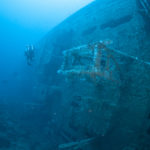
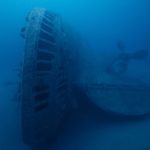
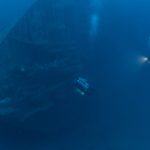
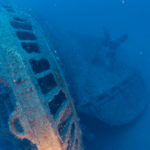
Resting on its port side in about 240 feet (73 m) of water, E.M. Clark is completely intact from bow to stern. It is one of the best representations of a World War II merchant ship off the North Carolina coast. Although the depth of the shipwreck will prohibit all but the most experienced technical divers from exploring the site, E.M. Clark nonetheless offers the technical diver a unique dive experience on a very well-preserved shipwreck.
“Visibility at the wreck site is stunning,” says Tane Casserley, Monitor National Marine Sanctuary’s research coordinator and NOAA diver.
“When you start at the bow, the prevailing current helps you to glide along the wreck, allowing you to truly experience the wreck and all the marine life. As you move toward the stern, the wreck begins to disappear behind you. Then you come to the fantail, which is beautiful. To me, the architecture of that section looks like the Statue of Liberty’s crown and offers a vivid reminder of why World War II was fought and why we work so hard to protect these shipwrecks.”
The site of E.M. Clark measures 499 feet long (152 m) and the site’s main feature is the steel hull, which lies mostly intact on its port side. The hull’s exterior steel plates are in excellent condition with only small areas of deterioration. The wreck’s highest point is the starboard side main deck, which sits at least 50 feet (15 m) off the seafloor.
The bow’s starboard anchor is in place and visible in the hawse pipe. The port-side anchor is buried in the sand under the vessel. Both anchor chains run up through the hawse pipes to the deck, where they wrap over the windlass and continue down into the chain locker. The deck plating in the bow has deteriorated, exposing beams and cross bracing. Additionally, there are large holes in the top of the main deck that allow access to interior compartments.
Moving aft, the bridge structure has fallen to the seafloor. Only the outline of where the bridge met the deck indicates where the superstructure once sat. The bridge and all of the associated components, including stateroom and pilothouse materials and portholes, are scattered on the seafloor in a large pile. The main deck planking in this area has also eroded away, exposing the interior of the empty cargo tanks.
All three of E.M. Clark’s masts have fallen over and lie on the seafloor. The skylight that sat above the engine room is gone, resulting in a large opening 20 feet (6 m) wide. The large, single rudder and two propellers and shafts are intact. The entire starboard propeller remains visible, but only half of the port side propeller protrudes from the sand.
Marine life on the E.M. Clark
Lying near the western margin of the Gulf Stream, the warm water and the remains of E.M. Clark make the perfect home for an ecosystem teeming with life. The artificial reef supports encrusting invertebrates and a wide variety of fish and sharks. This, coupled with the site’s historic significance, make this a popular spot for technical divers looking for an intact World War II shipwreck.
As with other World War II shipwrecks, E.M. Clark is a war grave. Visitors should not disturb the site, leaving the wreck and its artifacts in place for future generations.
In July 2013, NOAA’s Office of National Marine Sanctuaries nominated E.M. Clark for listing on the National Register of Historic Places and it was accepted. To learn more about the E.M. Clark and other World War II shipwrecks off the North Carolina coast, click here.
An expanded sanctuary
In an effort to honor the service and sacrifice of those lost during the Battle of the Atlantic, NOAA in 2019 will release a draft proposal to expand the boundaries of Monitor National Marine Sanctuary to include a nationally significant collection of shipwrecks that currently have little or no legal protection. The expansion would also establish the largest area designated as a World War II battlefield anywhere in the world.
To learn more about the proposal, click here.
By Shannon Ricles, Monitor National Marine Sanctuary
The post Preserving America’s Underwater Battlefield: E.M. Clark appeared first on Scuba Diver Life.
from Scuba Diver Life http://bit.ly/2GmuGXz
Wednesday, April 17, 2019
Social Work, Inc.: How Benefit Corporations Grow Your Business With Social Responsibility
from The New Social Worker Online — the professional social work careers magazine http://bit.ly/2InBWpm